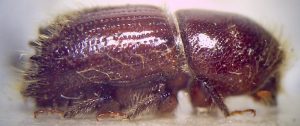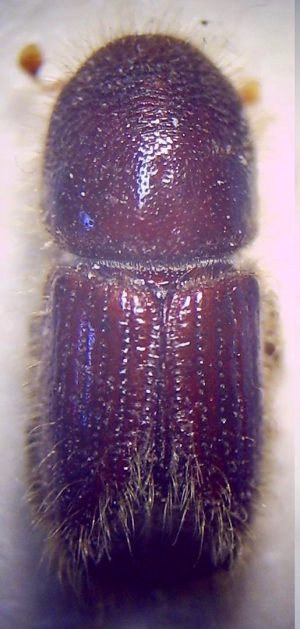Bark beetles : the larger eight toothed bark beetle

The woodlands’ blog has reported on outbreaks of bark beetles in the States and Canada but as of 16th January this year, measures were put in place to protect the UK from the larger eight toothed spruce bark beetle (Ips typographus). This beetle has been a problem on continental Europe for many years; it has been estimated that Germany lost some 30 million cubic metres of timber (between 1945 and 1949) to bark beetles. Spruce is a commercially important species, with perhaps some 800,000 hectares in the UK. On the continent, the beetle has also been found living in pine, larch and douglas fir. The beetle was found in Kent last December. The special measures restrict the movement of spruce in a 50 km area around the outbreak. Details of this area can be found here.
 The eight toothed spruce bark beetle has previously been found in traps set at British ports by the Forestry Commission. The beetles may make their way here in sub-standard pallets that have not been properly debarked. The beetle cannot survive in finished timber, it needs bark. It bores its way through the bark (in the living tree) and sets up a breeding site - about 200 beetles are needed to form such a colony.
The eight toothed spruce bark beetle has previously been found in traps set at British ports by the Forestry Commission. The beetles may make their way here in sub-standard pallets that have not been properly debarked. The beetle cannot survive in finished timber, it needs bark. It bores its way through the bark (in the living tree) and sets up a breeding site - about 200 beetles are needed to form such a colony.
The beetle is usually a pest of stressed or weakened trees (i.e. windblown, damaged or recently felled). Under the right conditions, the number of beetles can increase sufficiently for the beetles to attack even healthy trees. In winter, the adult beetles are dormant and ‘hibernate’ beneath the bark of trees and logs. Adult beetles are about 5mm long, roughly cylindrical in shape, dark brown, shiny and ‘hairy’. Their wing covers (elytra) form a ‘collar’ which is ‘surrounded’ by eight teeth, four on each wing cover (case). The adults emerge in Spring when the temperature warms up.
After mating, the females lay their eggs in galleries underneath the bark. Larvae hatch from the eggs and as they grow, they extend the gallery system. The pattern of these galleries can been seen in the surface of the wood / bark. The beetle can also carry the spores of certain blue-stain fungi, which germinate and affect the phloem (sugar condition tissue) and the cambium (a layer of dividing cells). Damage to these tissues plays a role in the death of trees.
Images of, and a guide to the symptoms / characteristics of infection by the larger eight toothed spruce bark beetle can be downloaded from: the publications section of gov.uk .
Images (with thanks) from Wiki Commons :
Fdcgoeul [GFDL (http://www.gnu.org/copyleft/fdl.html) or CC BY 3.0 (https://creativecommons.org/licenses/by/3.0)], from Wikimedia Commons
https://upload.wikimedia.org/wikipedia/commons/4/4d/Ips_typographus_Imago.JPG
Comments are closed for this post.
